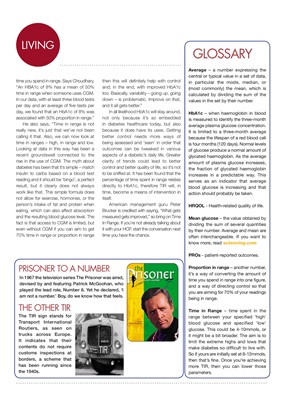
LIVINGLIVING
Average - a number expressing the
central or typical value in a set of data,
in particular the mode, median, or
(most commonly) the mean, which is
calculated by dividing the sum of the
values in the set by their number.
HbA1c - when haemoglobin in blood
is measured to identify the three-month
average plasma glucose concentration.
It is limited to a three-month average
because the lifespan of a red blood cell
is four months (120 days). Normal levels
of glucose produce a normal amount of
glycated haemoglobin. As the average
amount of plasma glucose increases,
the fraction of glycated haemoglobin
increases in a predictable way. This
serves as an indicator that average
blood glucose is increasing and that
action should probably be taken.
HRQOL - Health-related quality of life
Mean glucose - the value obtained by
dividing the sum of several quantities
by their number. Average and mean are
often interchangeable. If you want to
know more, read sciencing.com
PROs - patient-reported outcomes
Proportion in range - another number,
it's a way of converting the amount of
time you spend in range into one figure,
and a way of directing control so that
you are aiming for 70% of your readings
being in range.
Time in Range - time spent in the
range between your specified 'high'
blood glucose and specified 'low'
glucose. This could be 4-10mmols, or
it might be a bit broader. The aim is to
limit the extreme highs and lows that
make diabetes so difficult to live with.
So if yours are initially set at 6-12mmols,
then that's fine. Once you're achieving
more TIR, then you can lower those
parameters.
GLOSSARY
of 50% time in range when someone
uses CGM. In our data, with at least three
blood tests per day and an average of five
tests per day, we found that an HbA1c of
8% was associated with 50% proportion
in range."
He also says, "Time in range is not
really new, it's just that we've not been
calling it that. Also, we can now look at
time in ranges - high, in range and low.
Looking at data in this way has been a
recent groundswell connected to the
rise in the use of CGM. The myth about
diabetes has been that it's simple - match
insulin to carbs based on a blood test
reading and it should be 'bingo', a perfect
result, but it clearly does not always
work like that. This simple formula does
not allow for exercise, hormones, or the
person's intake of fat and protein when
eating, which can also affect absorption
and the resulting blood glucose level. The
fact is that access to CGM is limited, but
even without CGM if you can aim to get
70% time in range or proportion in range
then this will definitely help with control
In 1967 the television series The Prisoner was aired,
devised by and featuring Patrick McGoohan, who
played the lead role, Number 6. Yet he declared, 'I
am not a number.' Boy, do we know how that feels.
The TIR sign stands for
Transport International
Routiers, as seen on
trucks across Europe.
It indicates that their
contents do not require
customs inspections at
borders, a scheme that
has been running since
the 1940s.
THE OTHER TIR
PRISONER TO A NUMBER
and, in the end, with improved HbA1c
too. Basically, variability - going up, going
down - is problematic. Improve on that,
and it all gets better."
In all likelihood HbA1c will stay around,
not only because it's so embedded
in diabetes healthcare today, but also
because it does have its uses. Getting
better control needs more ways of
being assessed and 'seen' in order that
outcomes can be tweaked in various
aspects of a diabetic's daily life. Greater
clarity of trends could lead to better
control and better quality of life, so it's not
to be sniffed at. It has been found that the
percentage of time spent in range relates
directly to HbA1c, therefore TIR will, in
time, become a means of intervention in
itself.
American management guru Peter
Brucker is credited with saying, "What gets
measured gets improved," so bring on Time
In Range. If you're not already talking about
it with your HCP, start the conversation next
time you have the chance.